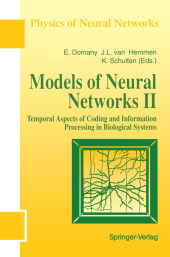 Neuerscheinungen 2011Stand: 2020-01-07 |
Schnellsuche
ISBN/Stichwort/Autor
|
Herderstraße 10
10625 Berlin
Tel.: 030 315 714 16
Fax 030 315 714 14
info@buchspektrum.de |

Eytan Domany, J. Leo van Hemmen, Klaus Schulten
(Beteiligte)
Models of Neural Networks
Temporal Aspects of Coding and Information Processing in Biological Systems
Ed. by Domany, Eytan; Hemmen, J. Leo van; Schulten, Klaus
2011. xvi, 347 S. XIII, 347 pp. 90 figs. 235 mm
Verlag/Jahr: SPRINGER, BERLIN 2011
ISBN: 1-461-28736-7 (1461287367)
Neue ISBN: 978-1-461-28736-0 (9781461287360)
Preis und Lieferzeit: Bitte klicken
Since the appearance of Vol. 1 of Models of Neural Networks in 1991, the theory of neural nets has focused on two paradigms: information coding through coherent firing of the neurons and functional feedback. Information coding through coherent neuronal firing exploits time as a cardinal degree of freedom. This capacity of a neural network rests on the fact that the neuronal action potential is a short, say 1 ms, spike, localized in space and time. Spatial as well as temporal correlations of activity may represent different states of a network. In particular, temporal correlations of activity may express that neurons process the same "object" of, for example, a visual scene by spiking at the very same time. The traditional description of a neural network through a firing rate, the famous S-shaped curve, presupposes a wide time window of, say, at least 100 ms. It thus fails to exploit the capacity to "bind" sets of coherently firing neurons for the purpose of both scene segmentation and figure-ground segregation. Feedback is a dominant feature of the structural organization of the brain. Recurrent neural networks have been studied extensively in the physical literature, starting with the ground breaking work of John Hop field (1982).


